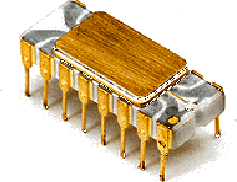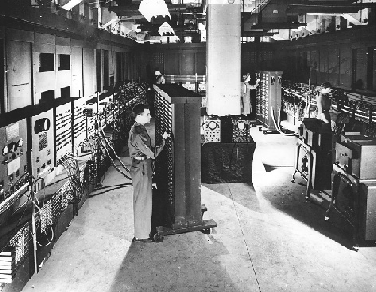
Figure 3: The Intel 4004
As in the inventions of the transistor at Bell Laboratories and the planar
technology at Fairchild Semiconductor, the next significant
development took place in a research environment in which a
smaller number of scientists mutually inspired each other in
the pursuit of their research goals.
In 1968, Robert N. Noyce, Gordon E. Moore and Andrew S. Grove
decided to leave Fairchild Semiconductor and form a new startup
company, Intel. With a 1-page business plan, they raised US$ 2.5 million
venture capital. In 1970, Intel introduced the 1103, a 4 kbit DRAM,
the first high-density semiconductor memory.
In mid-1969, Busicom, a now-defunct Japanese calculator manufacturer,
asked Intel to design a set of microchips for a line of high-performance
calculators. The specifications provided called for at least twelve
chips. Marcian E. Hoff of Intel decided that this solution was to
complex and expensive and came up with the concept of a general-purpose
information processor.

The performance of the 4004 had been designed to match the performance of Eniac, the first general-purpose electronic computer (see Figure 4) constructed using during World War II using approximately 19,000 vacuum tubes10).
The performance of the 4004 is estimated at 0.06 MIPS. From its inception in 1971, the microprocessor has grown exponentially in performance and complexity according to the predictions in Moore's law. By comparison, the Intel Pentium Pro (1995) is a 200 MHz chip with 5.5 million transistors and a performance of 428 MIPS.
As a general-purpose device, the microprocessor impacted electronic systems design severely. Since the early 1970's, a wide variety of electronic products have been realized using standard microprocessors. Unfortunately, the general-purposeness of microprocessors implied that not all electronic systems could reach the full potential of technology.

Author:
Flemming Stassen
(http://www.it.dtu.dk/~stassen/Edu/49260/Historie)